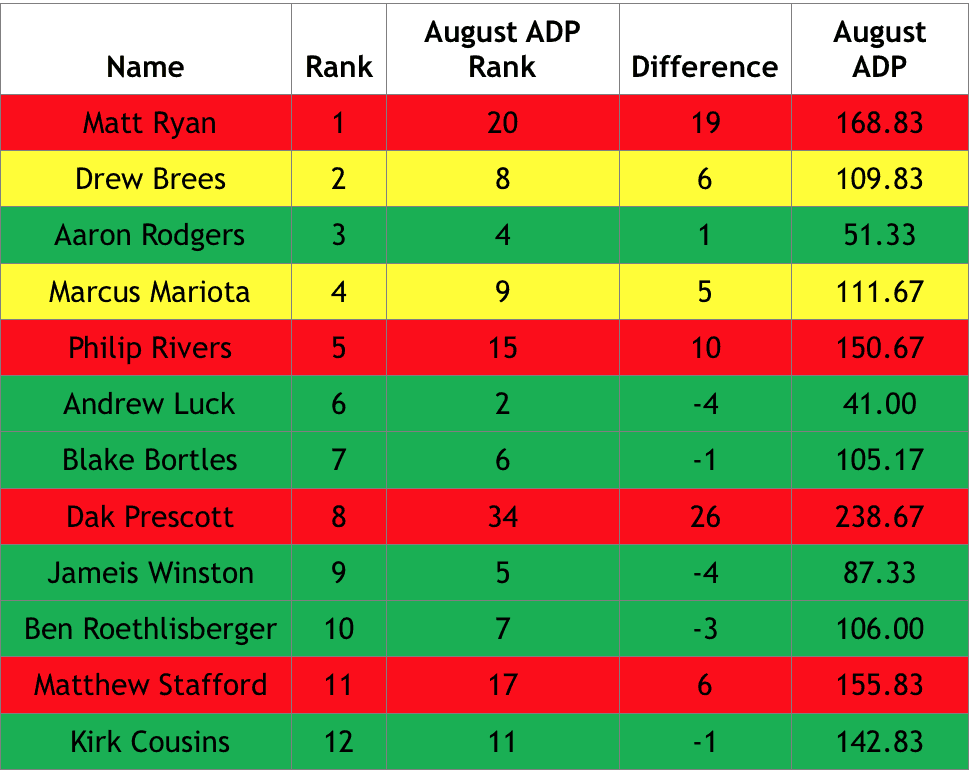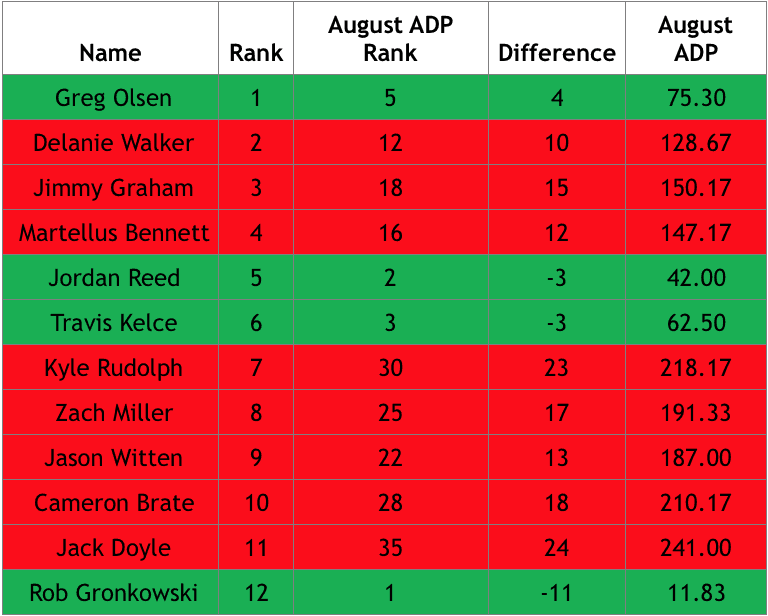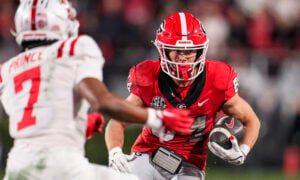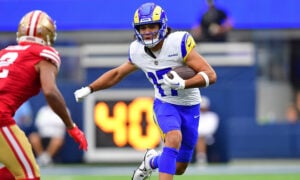Lessons for the Future, Part Two: The Juxtaposition of Dynasty and Fantasy Value
Many consider off-season and in-season happenings as separate entities. While I believe this is true to an extent, I’m also of the mindset that there are invaluable lessons we can glean moving forward, using the present as our basis of knowledge. To that extent, I’ve prepared this two-part series to analyze trends that could be of some use for evaluating the 2017 off-season market.
In the first article, I took a look at the shifts in value for our most treasured dynasty assets, highlighting some important lessons along the way. In this piece I want to branch away from players’ dynasty value into what they’re actually doing on the field. In other words, what type of fantasy value does each player possess?
If this doesn’t make sense so far, the long and short of it is this – to me, a player’s dynasty value is essentially perception. Regardless of how a player has produced, dynasty owners can effectively assign whatever value they want to him. Whether it be in a startup draft or on the trade market, a player’s dynasty value is manifested in terms of “currency,” not football production.
When it comes to fantasy value, that’s significantly more simple. If a player plays well, he puts up points for us in the fantasy box score. It doesn’t matter how old he is or what position he plays, fantasy points directly correlate to fantasy value.
Now of course, dynasty and fantasy values can overlap. Generally, players who possess significant fantasy value will have dynasty value as well. There are reasons why this may not be the case, including but not limited to age and positional scarcity. Attempting to project rookies and young players with no appreciable NFL experience can lead to the opposite (i.e. trying to get the breakouts before they break out).
To me, the best way to compare dynasty value to fantasy value is to associate each player’s ADP with his positional ranking. In that spirt, the below will focus on how the top fantasy players at each position (Top-12 quarterbacks and tight ends, and the Top-24 running backs and wide receivers) were valued in the preseason, juxtaposed with how they’re performing now. This will establish some clarity to the paths they’ve taken, hopefully providing us with a glimpse of what we can look for moving forward.
Let’s start with the signal callers.
[am4show have=’g1;’ guest_error=’sub_message’ user_error=’sub_message’ ]
Quarterbacks

The first thing you’ll likely notice is the color scheme. The traffic light motif shown above helps to signify players who have:
- Correlated dynasty value to fantasy value (green)
- Shown a slight difference between dynasty value and fantasy value (yellow)
- Shown a stark contrast between dynasty value and fantasy value (red)
Also of note is that the “August ADP Rank” column shows where each player was valued according to the August ADP. Matt Ryan, for example, was treated as the 20th most valuable quarterback in August startups, hence the #20. His rank is self-explanatory, as he’s the #1 fantasy signal caller on the season. The difference between the two is the ADP rank less the positional rank, and the August ADPs are shown for additional description.
Onto the analysis.
As can be gleaned from the above, quarterbacks have shown a 50% correlation between August ADP and positional value. The most glaring misses were older quarterbacks (Philip Rivers and Drew Brees), reclamation projects (Ryan and Matt Stafford), and a guy no one saw coming (Dak Prescott). Please note that although Stafford and Brees each saw differences of six slots, Brees was “yellow” due to the fact he was drafted as a QB1, whereas Stafford wasn’t.
Now many players did manage to correlate their dynasty value to fantasy value. Elite dynasty assets such as Aaron Rodgers and Andrew Luck have the play to match, and many of the back-end of the top-12 players saw similar dynasty value. All told, however, there’s not nearly as much green as we’d like to see.
Running Backs

Somewhat true to the popular belief, running back valuation is an essentially hit or miss proposition. Six of the top-12 valued ball carriers according to the August ADP saved face (note that I’ve included Le’Veon Bell as, on a per game basis he’s a top guy), one was drafted as an RB2 (Melvin Gordon), and five couldn’t even hit that threshold. Of the RB2 tier, three held value, two slipped from the RB1 ranks (Lamar Miller and Todd Gurley), and seven once again came from the lower level. All told, the correlation over the top-24 ball carriers chalked in at a miniscule 37.5%.
Wide Receivers

Incidentally enough, the receiver pattern resembles an actual traffic light. Five of the top six 2016 fantasy receivers were valued as such, followed by the slight miss on TY Hilton. Then the entire WR2 tier was basically a miss, with Allen Robinson falling from the WR1 ranks and every other pass catcher being drafted as the WR35 or below.
Okay, there are a few other guys in there – Larry Fitzgerald and Jordy Nelson represent the requisite “old man tier” in the WR1s. These are guys who will never be valued in accordance with their fantasy value, as dynasty owners seek longevity. The back end of the WR1 ranks effectively held firm, as did the tail end of the WR2s as well. The hits across the receivers wound up being 41.7%, or 45.8% if Hilton is included.
Tight Ends

The coup de grace in this dissection of relative values lies with the tight end position. In short, it’s a crapshoot. While stalwarts like Greg Olsen, Jordan Reed, Travis Kelce and Rob Gronkowski all held value (with Gronk, much like with Bell above, I’m looking at points per game versus games played), the rest was a nightmare. Literally every other player could’ve been had at an ADP below 128 (11th round), and the only other player drafted as a TE1 who’s performing as a TE1 is Delanie Walker. All told it’s a revolving door of value.
Lessons Learned
So with that data in hand, what lessons have we learned that we can apply to startup drafts moving forward?
- Late Round Everything? – Let’s say you’re doing a startup draft, and you feel like getting frisky in the trade market. Someone wants your first round pick, and you agree to something like your 1st, 9th, and 10th for his/her 4th/5th/6th. Without resorting to the fuzzy math of a trade calculator, this passes the “eye test,” right? I think so.
Anyhow, yes, you’d be passing up the dynasty and fantasy value of a stud player, which has largely held true in 2016. However, you could’ve also gained three players (in addition to your own picks in that range) such as a Doug Baldwin, Melvin Gordon and Michael Crabtree, who could be propelling you to a title as I type. Yes, I’m cherry-picking, and Part One of this series even showed the nebulous nature of picks in this region, but the point remains that given the uncertainty of dynasty value, you might be better off adopting a “throw crap against the wall” approach.
Now remember, if you’re smart you’re already fading quarterback and tight end. Given the type of replaceable production you can obtain, along with the fact these are generally start-one positions, there’s no reason to spend an early round pick here. So if you load up at running back and receiver, you could be well on your way to rounding out an elite starting lineup.
- Running Back is the New Wide Receiver – The rationale behind drafting receiver early was that they hold value. Yes, much of that is due to the fact they tend to play longer, and that remains true. But if you’re able to obtain a stud running back, it’s every bit as good as getting a stud receiver. Moreover, you now have nearly the exact same likelihood of correlating dynasty value to fantasy value, at least according to the data above. The seeming randomness that has previously affected running backs is now doing the same to the receiver position, and in my opinion the stigma is dead.
- Wait on QB and TE – I touched on this in the bullet above, but the point bears repeating. You’re only starting one guy, and you can get bankable production later on. If you want to beat the odds, play the lottery.
- Don’t Cast Off the Castaways – I’m not going to name every name, but there are numerous players above whose stars once burnt bright but faded over time. If you’re looking for players to snag in the middle to late rounds, why not take a chance on the guys who have done it before? I understand the allure of the unknown, but sometimes the tried and true still offer the same upside they once did.
Conclusion
I don’t want to be overly cavalier and suggest dynasty value isn’t important, as it can directly affect your dealings on the trade market. But fantasy value is what wins you games, and as can be gleaned from the above, it can be found in unexpected places. Every year will likely follow a different pattern, but if 2016 serves as even a fraction of an example, there are definitive ways to game the system moving forward.
Find me on Twitter @EDH_27
[/am4show]


































































